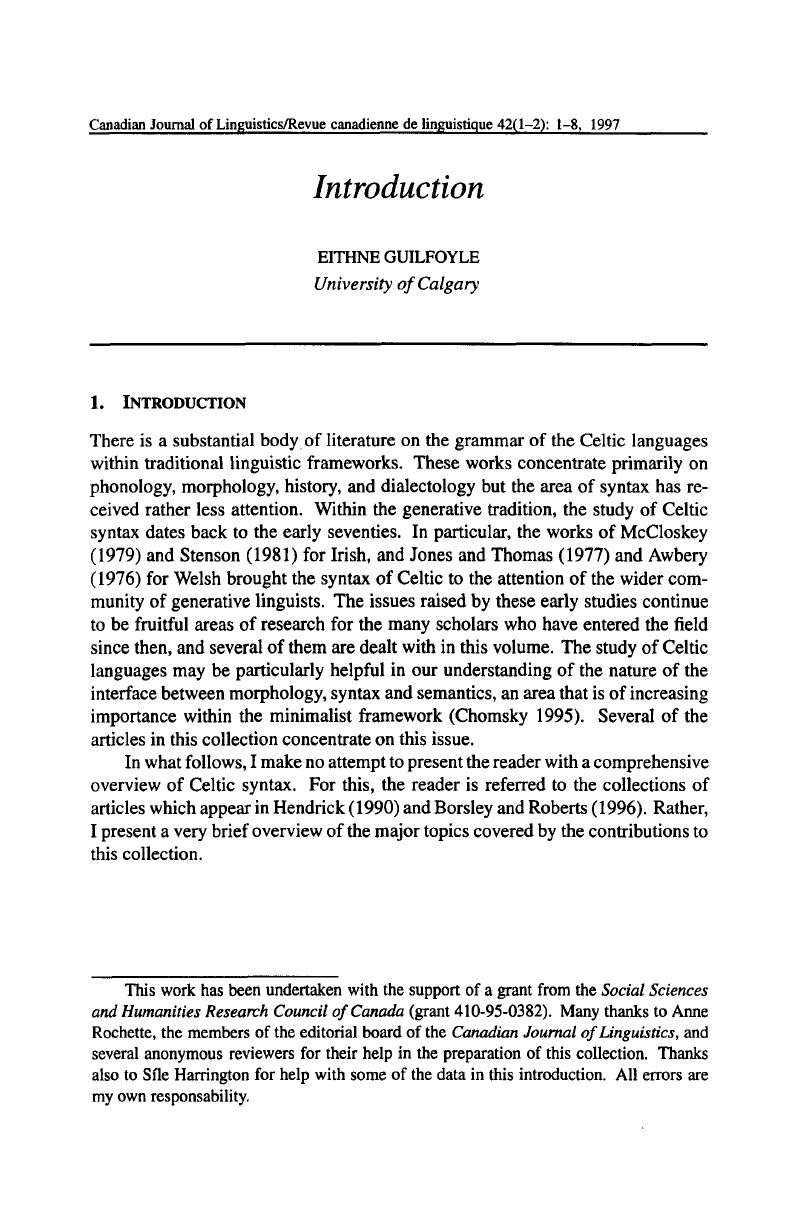No CrossRef data available.
Article contents
Introduction
Published online by Cambridge University Press: 27 June 2016
Abstract
An abstract is not available for this content so a preview has been provided. Please use the Get access link above for information on how to access this content.

- Type
- Articles
- Information
- Canadian Journal of Linguistics/Revue canadienne de linguistique , Volume 42 , Special Issue 1-2: Topics in Celtic Syntax , June 1997 , pp. 1 - 8
- Copyright
- Copyright © Canadian Linguistic Association 1997
References
Awbery, G.M.
1976. The syntax of Welsh: A transformational view of the passive. Cambridge: Cambridge University Press.Google Scholar
Bobaljik, Jonathan D., and Carnie, Andrew. 1996. A minimalist approach to some problems of Irish word order. In The syntax of the Celtic languages: A comparative perspective, ed. Borsley, Robert D. and Roberts, Ian, 223–240. Cambridge: Cambridge University Press.CrossRefGoogle Scholar
Borsley, Robert D., and Roberts, Ian, eds. 1996. The syntax of the Celtic languages: A comparative perspective. Cambridge: Cambridge University Press.Google Scholar
Chung, Sandra, and McCloskey, James. 1987. Government, barriers, and small clauses in Modern Irish. Linguistic Inquiry
18:173–238.Google Scholar
Emonds, Joseph. 1980. Word order in generative grammar. Journal of Linguistic Research
1:33–54.Google Scholar
Guilfoyle, Eithne. 1987. Parameters and functional projection. In Proceedings of NELS
18, ed. Blevins, Jamesand Carter, Juli, 193–207. GLSA, University of Massachusetts, Amherst.Google Scholar
Guilfoyle, Eithne. 1990. Functional projection and phrase structure parameters. Doctoral dissertation, McGill University.Google Scholar
Hendrick, Randall, ed. 1990. Syntax and semantics
23: The syntax of the modern Celtic languages. New York: Academic Press.Google Scholar
Jones, D., and Thomas, A.R.. 1977. The Welsh language: Studies in its syntax and semantics. Cardiff: University of Wales Press.Google Scholar
McCloskey, James. 1979. Transformational syntax and model theoretic semantics. Dordrecht: Reidel.Google Scholar
McCloskey, James. 1983. A VP in a VSO language. In Order, concord, and constituency, ed. Gazdar, Gerald, Klein, Ewan, and Pullum, Geoffrey K., 9–55. Dordrecht: Foris.CrossRefGoogle Scholar
McCloskey, James. 1990. Resumptive pronouns, A-bar binding, and levels of representation in Irish. In Syntax and semantics
23: The syntax of the modern Celtic languages, ed. Hendrick, Randall, 199–248. New York: Academic Press.Google Scholar
Neeleman, Ad, and Reinhart, Tanya. To appear. The syntax and interpretation of scrambling in Dutch. In Argument projection: Lexical and compositional factors, ed. Butt, Miriam and Geuder, Willi. Stanford: CSLI Publications.Google Scholar
Noonan, Máire. 1992. Case and syntactic geometry. Doctoral dissertation, McGill University.Google Scholar
Roberts, Ian, and Roussou, Anna. 1997. Interface interpretation. Paper read at the 20th GLOW Colloquium, Rabat.Google Scholar
Schafer, Robin. 1995. Negation and verb second in Breton. Natural Language and Linguistic Theory
13:135–172.Google Scholar
Sells, Peter. 1984. Syntax and semantics of resumptive pronouns. Doctoral dissertation. University of Massachusetts, Amherst.Google Scholar
Stump, Gregory. 1989. Further remarks on Breton agreement. Natural Language and Linguistic Theory
7:429–471.CrossRefGoogle Scholar


